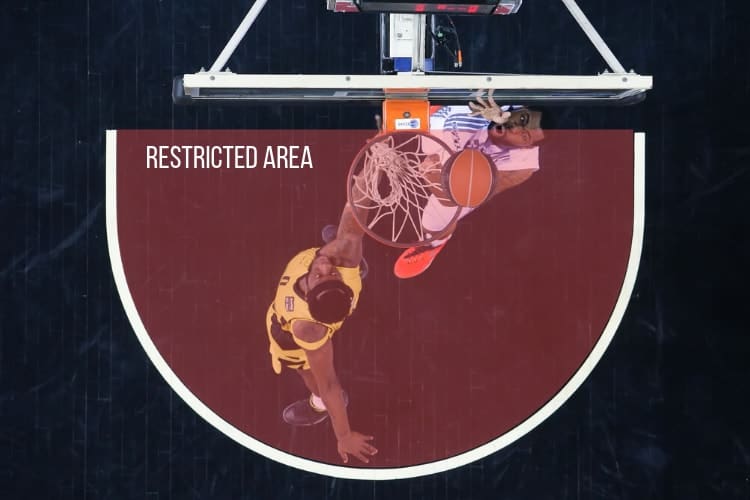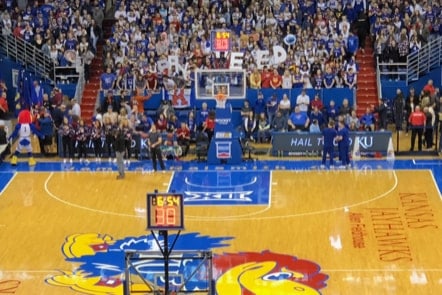The restricted area in basketball is something that might confuse you when you are first learning the sport. It can have a big impact on block and charge calls, which can swing the momentum of a game one way or the other. What is the Restricted Area in Basketball?
The restricted area in basketball is a semi-circle arc painted just under the basketball goal that outlines the area on the basketball floor where secondary, off-ball defenders are restricted from taking charges. Any secondary defender attempting to draw a charge inside the restricted area will automatically be called for a blocking foul.
The purpose of the restricted area in basketball is to keep secondary, off-ball defenders from sliding under offensive players as those offensive players drive to the basket. This not only helps reduce the risk of injury (since sliding in late under a leaping offensive player can cause nasty falls), but it also helps keep the game fair by providing the offensive player room to jump and land in an area of the floor where they clearly need to (next to the goal).
It’s important to note that the restricted area in basketball applies to the secondary defender, not a primary on-ball defender (more on that in the article below). Here is a picture of the restricted area in basketball:

In this article we will discuss in greater detail the restricted area in basketball, and go over in detail how it is applied to college basketball, NBA, and international basketball.
What is the Restricted Area in Basketball?
As we discussed above, the restricted area in basketball is the clearly defined semi-circle that exists directly under the basket. This semi-circle arc that extends 4 feet from the center of the basket. As the arc turns towards the baseline, it straightens out before it stops at the front edge of the backboard (source).
What is the Purpose of the Restricted Area in Basketball?
The restricted area serves two primary purposes.
- It helps prevent injury to airborne players.
- It gives penetrating offenses players a fair opportunity to jump (and land) in the scoring area, and prevents secondary defenders from gaining an unfair advantage by shifting under a player who beat their primary defender and jumped to score the ball.
Prior to the restricted area arc being implemented, secondary, off-ball defenders could slide in under offensive players who were about to jump to score (near the rim). This made it nearly impossible for offensive players to avoid a collision because the defenders knew that under the basket would be a great spot to draw a charge because the natural body motion of offensive players would carry them down into the defender.
Not only did this create an unsafe situation, it was clearly an exploitable advantage for defenders. The arc necessitates that a defender be completely outside the arced restricted area to be in a legal guarding position.
Defenders still have a reasonable chance to establish a legal guarding position outside the restricted area arc, but the arc gives an airborne offensive player safe access to land. The arc also gives officials a distinctly marked point on the court to help them make tough judgment foul calls between blocking fouls and a charging fouls.
Restricted Area in Basketball Rules
The rules regarding the restricted area in basketball are very similar throughout college basketball, NBA, and FIBA. It’s important to note that FIBA does use a bigger arc area (4.1 foot arc vs 4 foot arc). Here is a look at the restricted area arc painted on a college basketball floor:

NBA Restricted Area Rules
If you want to do a deep dive into the NBA rule book regarding the restricted area in the NBA, click here. But here are the 4 things you need to understand:
- The restricted area goes to the ceiling, meaning that even if a player has his back heel off the ground, if it is still over the restricted area, that player is still considered to be in the restricted area.
- A primary defender (the person guarding the ball) can legally draw a charge inside the restricted area against the player he is guarding.
- A secondary, off-ball defender cannot legally draw a charge inside the restricted area. This means if an offensive player is driving to the basketball, only the man guarding him can legally draw a charge inside the restricted area.
- Secondary defenders can make contact with offensive players inside the restricted area as long as they comply with the rules of verticality. The rules of verticality allow a secondary defender the opportunity to jump and contest a shot at the rim (inside the restricted area) as long as they (the defender):
- are in the air when the shot occurs
- maintain a vertical trajectory with body motion
- maintain a vertical alignment (arms straight up)
- don’t turn their body sideways
In summary, for a secondary player to make contact and contest a shot in the restricted area in the NBA, they must comply with the rules of verticality. To do this, they must be in the air when the shot occurs, have a vertical body motion (not jumping forward into the offensive player), keep their arms straight up, and keep their body straight.
It is also important to note that any offensive player entering the restricted area from the small area behind the basket does not get the protection of the restricted area, and can commit a charge against a secondary defender inside the restricted area.
Are Restricted Area Plays Reviewable in the NBA?
Yes, certain types of action inside the restricted area may be reviewed. Since the 2012-13 NBA season, officials have been allowed to review block/charge calls when they are unsure whether or not the defender was outside of the restricted area when contact was made (source). NBA officials can review:
- Whether the defender was inside or outside the restricted area when contact was made.
- Whether the offensive player committed any type of boundary line violation prior to the restricted area foul being assessed.
- Whether the defender was or was not set at the moment of contact.
- Whether or not the offensive player excessively led with an unnatural knee or foot to create space.
- Also, undercuts and excessive contact in the restricted area is subject to flagrant foul reviews.
College Basketball and International Basketball Restricted Area Rules
Although the rules that are applied to the restricted area in both college and international basketball are almost identical to the NBA rules, it’s important to note again that FIBA does use a slightly bigger restricted area arc (4.1 feet vs 4), which gives even more advantage to offensive players.
When Was the Restricted Area Added to the NBA?
The restricted area in basketball was first introduced by the NBA at the start of the 1997-98 season. There is now a restricted area used in the NBA, WNBA, European leagues, college basketball, and other types of international play.
When Was the Restricted Area Added to Men’s College Basketball?
The restricted area (known as the restricted arc area in college basketball) was implemented before the 2010-2011 season college basketball season. The lower divisions of college basketball did not implement the restricted area until the 2012-13 season. Initially, the restricted area arc was smaller in college basketball than it was in the NBA, but it has since been adjusted to match the 4-foot arc used in the NBA.
At first there was some discussion to keep the arc smaller due to the fact that the lane is smaller in college basketball than it is in the NBA. But because the restricted area is not so much a lane issue as it is a player safety and player control issue, the move to 4 feet was made to ensure that the restricted area can properly protect offensive players attempting to score.
